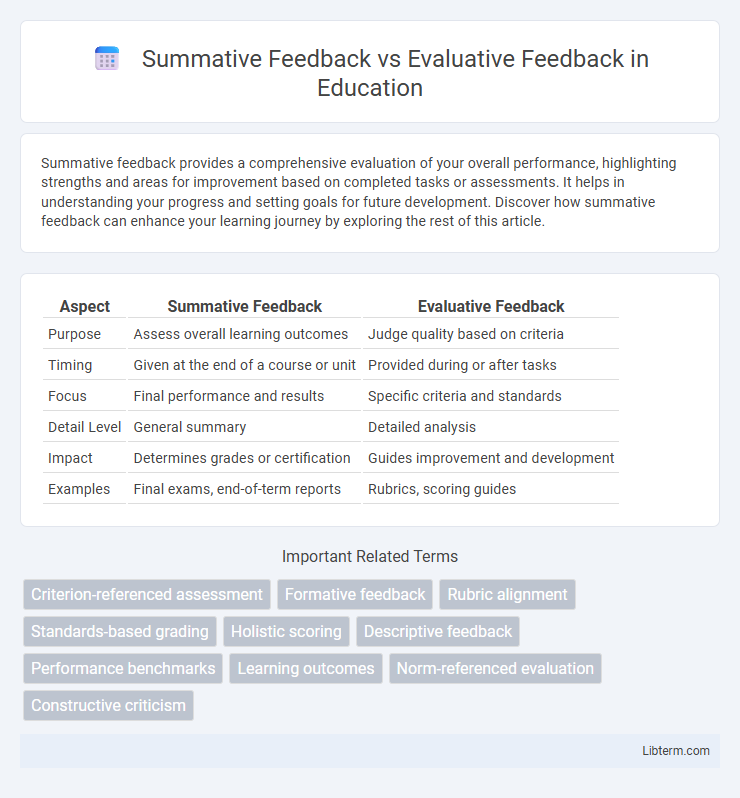Summative feedback provides a comprehensive evaluation of your overall performance, highlighting strengths and areas for improvement based on completed tasks or assessments. It helps in understanding your progress and setting goals for future development. Discover how summative feedback can enhance your learning journey by exploring the rest of this article.
Table of Comparison
| Aspect | Summative Feedback | Evaluative Feedback |
|---|---|---|
| Purpose | Assess overall learning outcomes | Judge quality based on criteria |
| Timing | Given at the end of a course or unit | Provided during or after tasks |
| Focus | Final performance and results | Specific criteria and standards |
| Detail Level | General summary | Detailed analysis |
| Impact | Determines grades or certification | Guides improvement and development |
| Examples | Final exams, end-of-term reports | Rubrics, scoring guides |
Understanding Summative Feedback: Definition and Purpose
Summative feedback provides a comprehensive assessment of learning outcomes, typically delivered at the end of an instructional unit to measure overall achievement against predefined standards. It serves the purpose of summarizing a learner's performance, offering insights into the effectiveness of teaching methods and learning processes. This type of feedback is crucial for high-stakes evaluations, such as final exams, standardized tests, or end-of-course assessments, to inform grading and certification decisions.
What is Evaluative Feedback? Key Characteristics
Evaluative feedback provides a judgment-based assessment of performance, often quantifying accomplishments against set standards or criteria. It is characterized by its summative nature, focusing on outcomes rather than the learning process, and typically involves assigning grades or scores. This type of feedback aims to measure competency and inform decisions about progression, certification, or final grading.
Summative vs Evaluative Feedback: Core Differences
Summative feedback summarizes overall performance, offering a final judgment often used for grading or certification, while evaluative feedback provides detailed insights aimed at assessing progress and guiding improvement. Summative feedback typically occurs at the end of a learning period or project, emphasizing outcomes, whereas evaluative feedback is ongoing and formative, focusing on criteria and standards. Understanding these core differences helps educators balance assessment methods to enhance both accountability and learning growth.
When to Use Summative Feedback in Learning
Summative feedback is best used at the end of a learning unit or course to assess overall student performance and mastery of content, providing a comprehensive evaluation of their understanding. It helps learners identify strengths and weaknesses by summarizing achievements against specific learning objectives or standards. Summative feedback is essential for grading, certifying competency, and informing future instruction adjustments.
Effective Situations for Evaluative Feedback
Evaluative feedback is most effective in performance reviews, standardized testing, and certification processes where objective measurement and grading are essential. It clearly defines success criteria and provides learners or employees with a definitive assessment of their achievement against set standards. This type of feedback supports decision-making in promotions, qualifications, or academic progression by highlighting areas that meet or fall short of expectations.
Impact of Summative Feedback on Student Performance
Summative feedback, delivered at the end of an instructional period, provides a comprehensive assessment of student learning, highlighting mastery of specific skills and knowledge. This type of feedback helps students identify their strengths and weaknesses, guiding future learning strategies and reinforcing content retention. Research shows that effective summative feedback can significantly improve student performance by clarifying achievement standards and motivating targeted improvement.
Advantages and Disadvantages of Evaluative Feedback
Evaluative feedback provides clear judgments on performance quality, enabling learners to understand their standing relative to standards and improve accordingly. However, it can sometimes discourage learners if overly critical or vague, potentially reducing motivation and hindering growth. The main advantage lies in its ability to deliver concise performance assessments, while its disadvantage is the risk of fostering anxiety or dependence on external validation.
Best Practices for Delivering Summative Feedback
Summative feedback should be clear, concise, and focused on overall performance outcomes, providing specific examples that highlight strengths and areas for improvement to guide future development. Best practices include delivering feedback in a timely manner after task completion, ensuring it is objective and aligned with established criteria or goals. Effective summative feedback fosters motivation by emphasizing growth potential and actionable insights rather than merely assigning grades or scores.
Enhancing Engagement with Evaluative Feedback
Evaluative feedback enhances engagement by providing clear, specific assessments that help learners identify strengths and areas for improvement, fostering a deeper understanding of their performance. This type of feedback offers actionable insights that motivate learners to reflect and actively participate in their growth process. Summative feedback, while useful for measuring overall achievement, often lacks the immediacy and detail needed to inspire ongoing engagement and development.
Choosing the Right Feedback Method: Practical Tips
Summative feedback provides comprehensive evaluations of overall performance, ideal for final assessments, while evaluative feedback focuses on specific criteria during the learning process to guide improvement. Choosing the right feedback method depends on the desired outcome: use summative feedback to measure achievement and evaluative feedback to support ongoing development. Practical tips include aligning feedback with learning objectives, timing feedback appropriately, and ensuring clarity to maximize effectiveness.
Summative Feedback Infographic

 libterm.com
libterm.com